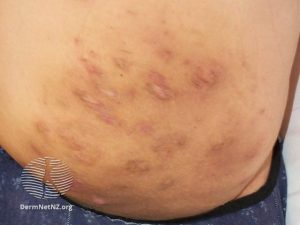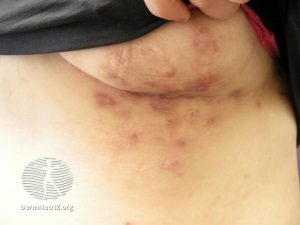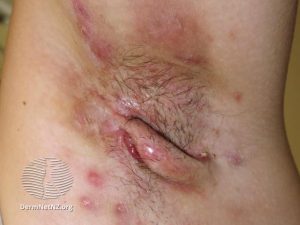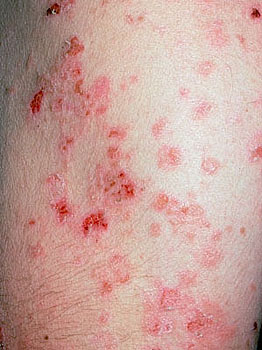Do you suffer from blackheads or abscesses on your underarms, groin, buttocks, inner thighs or breast? If you do, you might be having a rare skin disorder called Hidradenitis suppurativa (HS). Learn about this condition and inform yourself about its causes, symptoms, diagnosis and treatment.
What is Hidradenitis suppurativa?
Page Contents
- 1 What is Hidradenitis suppurativa?
- 2 Hidradenitis suppurativa Synonyms
- 3 Hidradenitis suppurativa ICD 9 Code
- 4 Hidradenitis suppurativa Incidence
- 5 Hidradenitis suppurativa Symptoms
- 6 Hidradenitis suppurativa Causes
- 7 Hidradenitis suppurativa Diagnosis
- 8 Hidradenitis suppurativa Differential Diagnosis
- 9 Hidradenitis suppurativa Surgery
- 10 Hidradenitis suppurativa Home Treatment
- 11 Hidradenitis suppurativa Risk Factors
- 12 Hidradenitis suppurativa Complications
- 13 Hidradenitis suppurativa Support Group
It is a chronic skin condition of the hair follicles and the skin regions containing sebaceous glands or apocrine sweat glands. It is characterized by the development of red, tender lesions and/or blackheads.
Hidradenitis suppurativa Synonyms
Considered to be a severe type of acne, the disease is also referred to as “Acne Inversa”. It is also known by various other names like:
- Acne conglobata
- Apocrine acne
- Apocrinitis
- Velpeau’s disease
- Verneuil’s disease
Hidradenitis suppurativa ICD 9 Code
The ICD 9 Code for this disorder is 705.83.
Hidradenitis suppurativa Incidence
The disease reportedly affects 1% of the general population. In the U.S, its prevalence is between 1-2% of the total population. The condition is said to affect females more than males. Severe cases of this disease are quite rare. But when mild cases of this disease are taken into consideration, 1 out of 100 individuals may be seen to suffer from HS.
In industrialized countries, the disease has been found to have 0.3-4% prevalence.
Hidradenitis suppurativa Symptoms
The common symptoms of HS include:
- Blackheads
- Scarring
- Tender, red lumps or abscesses
- Tunnels under the skin between abscesses
HS usually develops following puberty or during the end of the teenage years of a person. The nodules that develop due to this condition are painful and swollen in appearance. These tend to rupture after sometime, releasing pus and fluids from within. Even after they heal, the abscesses can leave ugly scars on the skin thus ruining the smooth appearance of the body.
As already mentioned, the nodules develop on skin regions that contain sebaceous glands. These include areas like:
- Buttocks
- Under the breasts
- Under the arms
- Scotum
- Around the anus
In less common cases, these may also develop on other areas of the body like:
- Waist
- Inner thighs
- Nape of the neck
In the early stages, the nodules present themselves as solitary and painful nodules. However, these may also arise in more than one regions of the body at the same time. The lumps may persist for weeks and even months, causing much pain and discomfort in sufferers. Some people, particularly those with multiple nodules, suffer much due to HS. Others only experience mild symptoms.
Stress, hormonal changes, excess body weight, excessive perspiration or heat may also worsen this problem.
Hidradenitis suppurativa Causes
The exact cause of this disease is not clear as yet. Doctors and medical researchers have suggested various factors that could be possible causes of this condition. These include:
Obstruction of sweat glands
The condition is often believed to arise due to a blockage of a sweat gland under the skin region where an HS nodule is found to develop on. The blockage may occur due to skin secretions, sweat or sebum released from the sebaceous glands. When the sweat fails to escape to the skin surface, it goes deeper into the adjoining tissue. An obstruction of hair follicles on a particular skin region may also give rise to the problem. When germs, such as bacteria, that usually reside on the skin surface get trapped in the blocked follicle or gland, it continues to multiply. This occurs as warm, moist environment is conducive to bacterial growth. Growth of bacteria in the tissues gives rise to inflammation and even infection at times. This ultimately leads to the formation of a nodule over the skin surface.
Undeveloped sweat glands
In some people, the sweat glands fail to develop in a proper way. This is also believed to result in improper release of sweat into the skin surface. Instead, the sweat moves deeper into the surrounding tissues and becomes responsible for the development of skin lesions.
Although the cause of blockage or improper development of sweat glands is not known, a number of factors have been considered to be the possible causes. These include:
- Obesity, or higher body weight
- Abnormality in the level of various hormones
- Genetics or family history of the condition
- Cigarette smoking
In some cases, the condition is also believed to be associated with disorders like Graves’ disease or Crohn’s disease.
Hidradenitis suppurativa Diagnosis
The diagnosis of HS involves observation and examination of the skin of patients. This is preceded by asking patients about the symptoms and an analysis of their medical history. If doctors notice pus or drainage, they may obtain a fluid sample from the released contents and send it for laboratory tests known as cultures. Cultures may be essential for ruling out presence of serious dermatological conditions, like Tuberculosis of the skin.
Although scans (such as MRI or CT scans) are not needed to diagnose the disease they might be used in the treatment of very severe cases of the disorder. These can help the direction where the sinus tracts go and their depth in the body of patients. A surgery can be planned accordingly.
If there are symptoms of infection, swabs might be taken to check which germs are multiplying in the pus. This can help determine whether or not antibiotics should be used and which ones are apt for treatment.
Hidradenitis suppurativa Differential Diagnosis
The differential diagnosis of HS involves distinguishing it from conditions with similar symptoms, such as:
- Acne
- Actinomyces
- Crohn’s disease
- Furunculosis
- Lymphogranuloma venereum
Such diagnosis may also aim at differentiating the disorder from ingrowing hairs, common boils, skin infections and abscesses that it is often confused with. Tests might be necessary to tell apart HS symptoms from those caused by such conditions.
In some cases, an analysis of blood glucose (sugar) levels should be done to check whether the patient is actually suffering from diabetes. This is because people with diabetes are more prone to skin infections.
During differential diagnosis, doctor might also recommend blood tests to check the level of inflammation or infection and also to make sure that the person is not anemic.
Hidradenitis suppurativa Treatment
Although there is no specific treatment for this disorder, early cure can help manage its symptoms and prevent development of new nodules.
The nature of medical treatment used for HS depends on the extent to which areas have been affected. It also depends on whether the sores are infected or painful.
Mild cases of HS can be cured with the help of self-management that includes regularly washing the region with an antibacterial soap and applying warm compress over it. Minor cases may need medicinal treatment in the form of topical application (which have to be rubbed on affected regions) or oral medications (which have to be taken through the mouth).
Some of the possible medicines for HS treatment include:
Antibiotics
Antibiotics, when taken for a long duration in the early stages of the disease, can help fight bacterial infection. It may also prevent outbreaks of the disease in future or stop the condition from worsening.
Oral retinoid medications
These drugs help stop functioning of the oil glands by prevent the blockage of the hair follicles.
Non-steroidal anti-inflammatory drugs
These are effective in reducing pain and inflammation occurring due to this disorder.
Immunosuppressant drugs or Corticosteroids
These may help decrease swelling, particularly in the initial stages of the disorder.
Tumor necrosis factor (TNF)-alpha inhibitors
These medications are effective for short term treatment of HS. There can be risks involved with long-time use of these classes of drugs.
Hidradenitis suppurativa Surgery
Surgery may be necessary for treating acute cases of the disease. This might be in the form of:
Uncovering the tracts
This involves ablation of skin and flesh over any tracts or tunnels to reduce scarring and promote healing.
Incision and drainage
This is useful for removal of lesions or promoting drainage in a single, small skin region.
Operative removal
It involves skin grafting or directly closing skin flaps to remove entire affected skin.
Although surgical treatment helps cure the condition in a single region, it is unable to prevent its recurrence in multiple spots.
Hidradenitis suppurativa Home Treatment
Mild cases of HS can be treated at home with the aid of natural remedies which can be effective in speeding up healing, preventing spread of infection and relieving discomfort. Natural treatment for the disease involves:
Applying warm compresses
Applying heat on the region with a warm compress or washcloth to reduce inflammation
Wearing loose clothes
Wearing tight-fitting synthetic clothes may irritate the skin and give rise to nodules over the body. Loose-fitting under-wears and clothes can help prevent irritation of skin and also help air-dry the skin.
Keeping the affected area clean
Gently washing the affected region with an anti-bacterial soap and applying an over-the-counter topical antibiotic medication on the area can keep the spot clean and disinfected.
Non-smoking
Although the effects of smoking have not been clearly established on HS patients, cessation of the habit has been believed to improve the course of the disorder.
Losing weight
Excess body weight may cause a number of regions of the skin to rub together, such as between the folds, and lead to friction, excessive perspiration and growth of bacteria. Although weight loss is not known to cure HS, it is believed to improve its symptoms.
Avoiding shaving
Shaving can irritate the skin region and worsen the problem. It is better to stop shaving until the nodules heal completely.
Hidradenitis suppurativa Risk Factors
The condition is found to be more common in:
Women
Females are found to be three times likelier than males to suffer from this disease. Although Perineal involvement is more common in men, Inguinal, Axillary and Submammary involvement is observed more in women.
Older teens or young adults
The disorder commonly arises in teen years or at the end of puberty. In many cases, the nodules of HS are found to arise in people aged between 20-30 years.
African-Americans
Dark skinned people have more apocrine glands than whites and it is probably due to this reason that African-Americans tend to suffer more from this disorder.
Acne sufferers
People with a history of acne are more susceptible to this disease.
Smokers
People who smoke cigarettes are at greater risk of developing this ailment.
Diseased individuals
People suffering from disorders such as diabetes can be more susceptible to the condition. It is also said to have a higher incidence in those who have undergone Lithium therapy.
Obese people
People who have higher body weight are more susceptible to this disease.
Hidradenitis suppurativa Complications
The physical complications of this disease include:
- Chronic infection, which might give rise to amyloidosis, anemia, renal failure and hypoproteinaemia
- Chronic malaise
- Lymphoedema and Lymphatic Obstruction, caused by scarring
- Generalised arthropathy, due to long-term persistence of this disorder
- Formation of fistula in the rectum, bladder, peritoneum and urethra (in rare cases)
Recurrent abscesses and nodules, caused by HS, can give rise to emotional problems like:
- Depression
- Social isolation
- Heightened self-consciousness
The less-common complications include acute infections and limited movement due to a deposition of scar tissues (Fibrosis). In rare cases, a form of skin cancer known as Squamous Cell Carcinoma, can occur.
In some cases, the lesions caused by this ailment tend to recur. The nodules are mostly observed to recur in the same region and result in chronic sinus formation. This is accompanied by intermittent discharge of blood or serous fluids.
Hidradenitis suppurativa Support Group
If you are suffering from acute cases of HS, you may consider getting in touch with a support group like Hidradenitis suppurativa Foundation Inc. This is a non-profit organization that has been set up to improve the quality of life of HS sufferers as well as their families. Its registered address is:
Hidradenitis Suppurativa Foundation, Inc.
7895 Via Belfiore #4
San Diego, CA 92129
Website: http://www.hs-foundation.org
If you suspect yourself to be having Hidradenitis suppurativa, seek immediate medical attention. As aforementioned, an early treatment can help manage the symptoms of HS and prevent formation of new lesions. It can also help you avoid complications and live as normally as possible.




